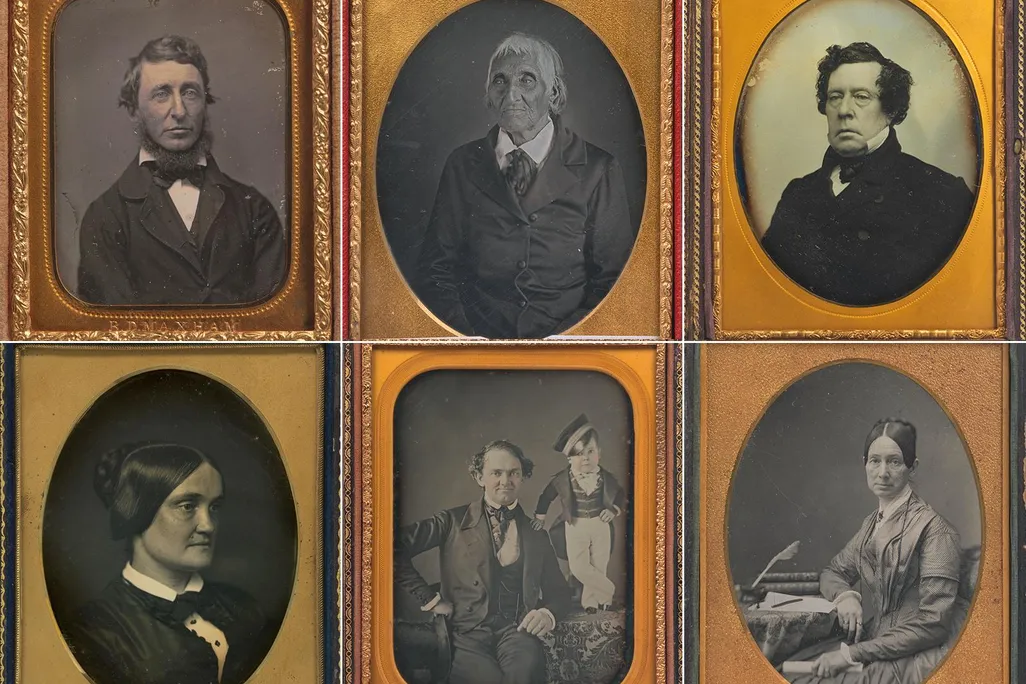Collecting Resources:
19th Century Photograph Type Cheat Sheet:
Daguerreotypes
Daguerreotypes: The first form of photography unveiled to the world in 1839. These high quality mirror like photographs are prepared on a rolled copper plate with a pure, highly polished silver surface.


Salt Prints:
Developed by Henry Fox Talbot (publically released in 1839) these early paper positive prints were popular up until circa 1860. A piece of paper was sensitised using silver nitrate and salt solution and then placed in the camera to develop (printing out process with longer developing time into the hours). Upon removing from the camera, the print was washed with a hypo solution to stop its continued sensitivity and make it light-fast. Salt prints and calotypes are notorious for their fading over time. Un-faded and immaculate salt prints command a huge premium over the often found faded versions.
Calotypes:
A refinement of the salt print method Talbot patented his calotype or Talbotype process in 1841. It is the ancestor of modern photography utilizing paper negatives to print multiple positive paper images (developing out process with shorter development times). Like salt prints, the image sits on, and sinks into, a rough paper surface creating a mottled lower res appearance. When looked upon at an angle, the surface appears matt in nature. Towards the end of its popularity you can
sometimes find albumenized salt prints where an egg white layer was brushed over to seal the image. It is often hard to tell the difference between these and albumen prints.


Ambrotypes (or Collodian Negative):
Developed by Frederick Scott Archer in the early 1850’s this
method quickly became popular and began to supplant the daguerreotype process due it is ease of use (despite its inferior image quality). A collodian coating was applied to a sheet of glass and
exposed in the camera. These images are often confused with daguerreotypes but lack the mirror like surface. The back of the glass plate would be painted black (or a dark card introduced behind) to
produce a positive image.
Tintype (also known as a melainotype or ferrotype):
Made by creating a direct positive on a thin
sheet of metal coated with a dark lacquer or enamel. Adolphe-Alexandre Martin invented the process in France during 1853 and it saw its heyday last from the 1860’s and 1870’s. This was a cheaper progression on from the collodian ambrotype and remained popular until demand waned at
the end of the 1800’s.


Albumen Prints:
A paper printing process invented in1850 and popular for the next 40 years. It produced a higher definition print than that of a salt print. It gets its name from the application of an egg white layer spread onto the paper surface. Where a salt print’s surface is matt in nature,
albumen’s surface is more gloss. Subset Albumen Sizes: CDV Cards (carte de visite) (Albumen Paper On Card): These are small albumen prints glued onto small card stock generally measuring 64
mm (2.5 in) × 100 mm (4 in). They were first devised for business and advertising purposes. Cabinet Cards (Albumen Paper On Card): Larger than CDV’s and typically measuring 108 by 165 mm
(4 1 ⁄ 4 by 6 1 ⁄ 2 inches). Mammoth Photographs (Albumen Paper): Typically anything over 15 inches.
3d Effect Stereoviews:
The later and most numberous stereoview are made with 2 albumen prints taken from slightly different angles. The first specimens though were made with daguerreotypes. Can also be found utilizing salt prints, ambrotypes and tintypes. They typically measure 7 x 3.5
inches.


Gelatin Silver Prints:
Developed in the 1870’s and eventually supplanting albumen prints by the late
1800’s, this method produces black and white images from negatives. They were easier to produce and were less prone to yellowing than albumens. This method is still in use today.
Daguerreotype Plate Sizes:
Full or Whole Plate: 16.5 x 21.5 cm or 6.5 x 8.5 inches
Three Quarter Plate: 12.37 x 16.12 cm or 4.87 x 6.37 inches (more common in Europe)
Half Plate: 11 x 14 cm or 4.25 x 5.5 inches
Third Plate: 16.5 x 21.5 cm or 3.85 x 4.75 inches (more common in Europe)
Quarter Plate: 8 x 11 cm or 3.25 x 4.25 inches
Sixth Plate: 7 x 8 cm or 2.75 x 3.25 inches
Ninth Plate: 5 x 6 cm or 2 x 2.5 inches
Sixteenth Plate: 3.5 x 4 cm or 1.375 x 1.625 inches
Daguerreotype Plate Hallmarks/Stamps
A great website for identifying plate hallmarks:
http://www.gri.it/storia-della-fotografia/dagherrotipia-daguerreotype/111-daguerreotype-hallmars-table-tavola-di-
identificazione-e-classificazione-punzoni-per-dagherrotipia.html
Industry Links:
Daguerreian Society http://www.daguerre.org/
Daguerreobase http://www.daguerreobase.org/en/
Dennis Waters (Dealer) http://www.finedags.com/
Greg French (Dealer) http://gregfrenchearlyphotography.com/
Mike Medhurst (Dealer) http://www.mikemedhurst.com/
Jeffrey Kraus (Dealer) http://antiquephotographics.com
London Photo Show www.photofair.co.uk
Any Queries?
Give me a call at 44 (0) 7570-349117
We are always here to here to respond and on time.
Thank you
